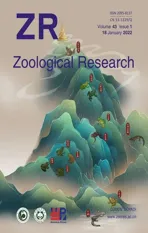目录
- Zoological Research shines in the East
- Cenozoic Tethyan changes dominated Eurasian animal evolution and diversity patterns
- Genome-wide association study identifies quantitative trait loci affecting cattle temperament
- Opah (Lampris megalopsis) genome sheds light on the evolution of aquatic endothermy
- Comparative mitogenomic analyses unveil conserved and variable mitogenomic features and phylogeny of Chedrinae fish
- A new species of the gudgeon genus Huigobio Fang,1938 (Cypriniformes: Cyprinidae) from the Yangtze River Basin, southern China
- Multidimensional amphibian diversity and community structure along a 2 600 m elevational gradient on the eastern margin of the Qinghai-Tibetan Plateau
- Unexpected expression of heat-activated transient receptor potential (TRP) channels in winter torpid bats and cold-activated TRP channels in summer active bats
- Overexpression of Twist1 in vascular endothelial cells promotes pathological retinal angiogenesis in mice
- COSINE: A web server for clonal and subclonal structure inference and evolution in cancer genomics
- Whole-genome resequencing infers genomic basis of giant phenotype in Siamese fighting fish (Betta splendens)
- Role of Cyp19a1 in the female pathway of a freshwater turtle species (Mauremys reevesii) with temperaturedependent sex determination
- A new species of Occidozyga Kuhl and van Hasselt,1822 (Anura: Dicroglossidae) from Southern Guangxi, China
- A new species of the genus Kurixalus (Anura:Rhacophoridae) from Sichuan Province, southwestern China
- Sichuan hot-spring snakes imperiled: reason, situation,and protection
- Capsid protein from red-spotted grouper nervous necrosis virus induces incomplete autophagy by inactivating the HSP90ab1-AKT-MTOR pathway
- Lack of transcriptional coordination between mitochondrial and nuclear oxidative phosphorylation genes in the presence of two divergent mitochondrial genomes
- Rapid genetic divergence and mitonuclear discordance in the Taliang knobby newt (Liangshantriton taliangensis, Salamandridae, Caudata) and their driving forces
